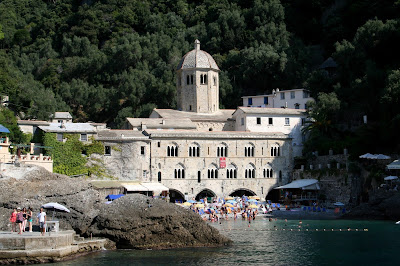This key epithet of Jesus Christ -- translated from Latin -- means “Word of God.” Not surprisingly, “Verbum Dei” is evident everywhere you may
travel in Italy -- from its largest cities to its smallest villages -- in all of the country's churches,
cathedrals and abbeys.
We had no fewer than five churches of varying size and shapes within three blocks of our hotel. The extraordinary Benedictine abbey (above) at San
Fruttuoso featured one of the more spectacular settings, sheltered within dense
foliage in a deep inlet.
As
the hub of Catholicism since the 4th century A.D., Italy truly has some of the most visually compelling houses of worship in the world. With more than 1.2 billion members worldwide, the Roman Catholic Church is based in Vatican City in Rome and led by the recently christened Pope Francis from Argentina. The church, of course, has played a prominent role in the development of Western civilization, for better or worse.
But
if you’re looking for jaw-dropping clerical art -- sculptures, paintings, stained
glass, murals, frescoes, you name it -- then the churches of Italy are worthy of any time you might spend in closer
examination.
A mere two blocks away from the Hotel Cristoforo Colombo, the
black-and-white-striped Cattedrale Di San Lorenzo (St. Lawrence) definitely has the gothic
look with twisting columns and crouching lions.
Built
in 1118, the cathedral features two bell towers added in the 16th century, and was our morning wake-up
call for breakfast on the terrace every morning.
You don’t see Old Testament
characters in Roman Catholic Churches in the U.S., but this compelling statue of David (right), displaying the severed head of Goliath after defeating the
giant in battle, stood out amongst the others.
Practically right next door, The Church of Jesus -- a Jesuit cathedral established in 1592 -- features an intricate pattern of artwork under the cupola, or dome, at its top.
There clearly is no lack of exaggeration and grandeur in keeping with the taste of the time: Baroque art, known for its movement, passion and restlessness.
Up the hill past the two towers of the Porta Soprana is the Church of Peter and Paul, another house of God filled with beautiful artwork.
I found this statue of Martha and Mary (right), two female disciples who tended to the body of Jesus after his death by crucifixion, to be the most interesting piece; according to the New Testament, Jesus Christ had raised Lazarus, the brother of Mary and Martha, from the dead.
Paradoxically, Italian churches seem to be often empty even on Sundays, except for tourists. Roman Catholics comprise the largest religious group at nearly 88 percent of the Italian population, although Catholicism is no longer officially the state religion.
Most Italians believe in God, or some form of spiritual life force. However, Italians tend to favor civil unions and the country is officially secular. Nonetheless, Christmas -- celebrating the birth of Christ -- remains a popular holiday among Italians.
Practically right next door, The Church of Jesus -- a Jesuit cathedral established in 1592 -- features an intricate pattern of artwork under the cupola, or dome, at its top.
There clearly is no lack of exaggeration and grandeur in keeping with the taste of the time: Baroque art, known for its movement, passion and restlessness.
Up the hill past the two towers of the Porta Soprana is the Church of Peter and Paul, another house of God filled with beautiful artwork.
I found this statue of Martha and Mary (right), two female disciples who tended to the body of Jesus after his death by crucifixion, to be the most interesting piece; according to the New Testament, Jesus Christ had raised Lazarus, the brother of Mary and Martha, from the dead.
Paradoxically, Italian churches seem to be often empty even on Sundays, except for tourists. Roman Catholics comprise the largest religious group at nearly 88 percent of the Italian population, although Catholicism is no longer officially the state religion.
Most Italians believe in God, or some form of spiritual life force. However, Italians tend to favor civil unions and the country is officially secular. Nonetheless, Christmas -- celebrating the birth of Christ -- remains a popular holiday among Italians.








No comments:
Post a Comment